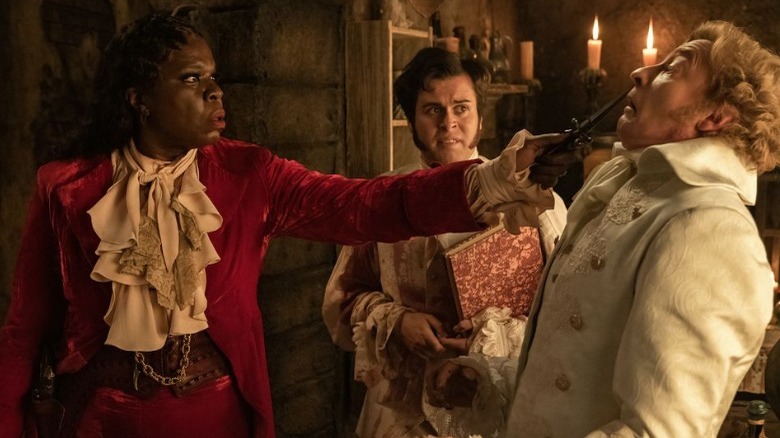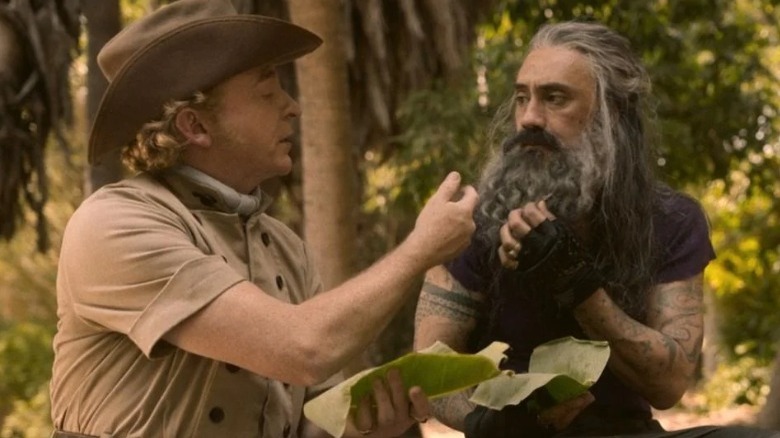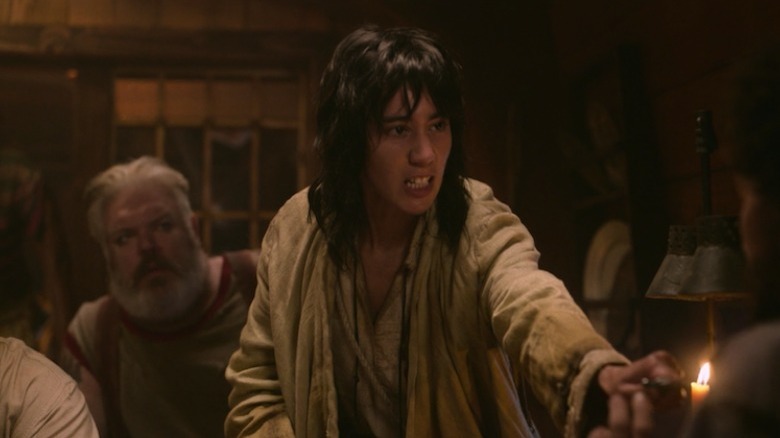
If you've recently gotten on board HBO Max's joyful and surprising new pirate show "Our Flag Means Death," you may be hankering for some historical context for all the drama. Well, you've come to the right place! While David Jenkins' historical rom-com plays fast and loose with its portrayal of the golden age of piracy, it also sails close to the truth in some key ways.
Did Stede Bonnet (Rhys Darby) really love Blackbeard (Taika Waititi)? Was pirate life as gnarly as it's been portrayed on screen in the past, or as sweet as life on the "Revenge" is in this show? Once you've finished yelling and crying and making fanart over this week's emotional roller coaster of a finale, buckle in for the answers to these questions and more with a brief /Film history lesson.
Which Characters In Our Flag Means Death Are Based On Real Pirates?

Several of the pirates from "Our Flag Means Death" are based on real people, although they do come from a period of history that's rife with lore and legend. This makes it tough to say for certain which elements of these pirates' stories were real and which were exaggerated, but that also leaves plenty of room for creative interpretation–which is perfect for a story like Jenkins'.
Importantly, our two main squeezes, Stede Bonnet and Edward "Blackbeard" Teach, were real pirates. According to Smithsonian Magazine, Bonnet came from an upper-class background, but gave up that life and left his family to take to the seven seas during the golden age of piracy. His story is a little less rosy than the one we see in "Our Flag Means Death," as his lack of pirate know-how led to his capture and execution within two years of his career change. Lucky for us (and Stede), show creator David Jenkins told /Film he's not afraid of departing from the course of history. While writing the show, he said he was always careful not to "kill this with research."
For his part, Blackbeard has long been spoken about as one of the most fearsome pirates in history, but recent scholarship has shown a different side of him. Just as "Our Flag Means Death" plays around with the idea that Blackbeard is a sheep in wolf's clothing, Smithsonian Magazine notes that "despite Blackbeard's terrible reputation, no evidence exists that he ever killed anyone before his final battle." Blackbeard towered in public imagination as a frightening figure for centuries, and is still widely known for his supposed ruthlessness.
Other historical figures in "Our Flag Means Death" include Izzy Hands (Con O'Neill), who was also known as Basilica Hands, and Blackbeard's old pal Calico Jack (Will Arnett), whose real name was John Rackham. All four of these men sailed the high seas around the same time, popping up in history books around the 1710s. Leslie Jones' character, Spanish Jackie, seems to be based on someone named Jacquotte Delahaye, who may have been real but more likely was the stuff of legends, according to the Royal Museums Greenwich.
Did Stede Bonnet Really Have A Pirate Mid-Life Crisis?

Stede Bonnet did indeed leave his family for a life of piracy, but as the show demonstrates, calling it a simple mid-life crisis may be reductive. According to Smithsonian Magazine, Bonnet was a wealthy landowner in Barbados when he decided to forsake not only his wife and children, but his fortune as well. The 1724 pirate lexicon "A General History of the Pyrates" explained Bonnet's reasons for leaving as a result of "disorder in the mind" and "discomforts he found in the married state." This is extremely non-specific, meaning that historians can read it as a mid-life crisis while the team behind "Our Flag Means Death" could just as easily read it as a crisis of sexuality.
Much of the novelty surrounding Bonnet's story comes from examining him from the perspective of his wealthy peers rather than his fellow pirates, who would have better understood his motives. Why would you give up your wealth and status for something so dangerous? In its deep dive on Bonnet, Smithsonian Magazine points out that pirating wasn't just a villainous act, but "a lifestyle, a profession and a political cause." My perspective is almost surely colored by the sweet version of Stede we've seen in the show, but I think it's entirely possible someone could feel motivated to try out piracy not because they were having some sort of breakdown, but because they longed for the freedom from the status quo that the lifestyle would afford.
Were Stede Bonnet And Blackbeard Romantically Involved?

Historians don't seem sold on the idea that Blackbeard and Bonnet were romantically linked, but there's ample evidence that they were very close at one point. Historical accounts differ, but Smithsonian Magazine explains that when the two crossed paths in Honduras, "Bonnet was thrilled to make Blackbeard's acquaintance, and the two pirate captains agreed to cruise together." The good times didn't last, though, as Blackbeard took over command and eventually marooned the men of the "Revenge" on an island.
Another account, this one by the South Carolina Historical Society, confirms that Blackbeard captained "Revenge" while Bonnet recovered from injuries. The two at one point parted ways, but ended up together again, plundering their way across the ocean as they sailed to South Carolina.
In the oft-referenced 1982 book "Sodomy and the Pirate Tradition," B.R. Burg makes the case that casual same-sex dalliances among pirates were common, and isn't the only historian to do so (more on that below). Burg does take it a step further than most, though, by mentioning this particular pair by name in a queer context -- albeit without coming to any strong conclusion about their relationship. The author points out that, "Like Blackbeard, his mentor in the buccaneering trade, Bonnet saved only male prisoners. Women were neither needed nor wanted aboard his ship."
Were There Really LGBTQ+ Pirates?

Absolutely! As mentioned above, a pirate's life at sea was free from many of the social restrictions of land-locked life, and that freedom extended, to some extent, to sex and gender. Pirates actually had their own version of gay marriage, called matelotage. According to All That's Interesting, accounts of matelotage are broad, encompassing everything from platonic economic partnerships to relationships that would now be considered pedophilic. Yet in many cases, matelotage was clearly a sexual and romantic partnership between consenting adults. In fact, at one point it became so popular that a Caribbean governor requested 2000 female sex workers from France to try to curb matelotage. Naturally, he couldn't stop the seafarers from doing what they pleased out on open waters.
Pirates also expanded the boundaries of gender expression. Two pirates, Mark Read (commonly referenced as Mary) and Anne Bonny, were born as women but began dressing in typical men's clothing at a young age and later went on to live as men among pirate crews. While there aren't primary sources that shine light on Read and Bonny's innermost thoughts about their gender identities, we know that they may have been lovers, and that they spent much of their lives presenting as men. These pirates likely helped inspire the great "Our Flag Means Death" character Jim (Vico Ortiz), a member of the Revenge crew who initially wears a fake beard before casually coming out as non-binary once their disguise is discovered.
Were Pirate Crews As Diverse As The Show Depicts?

"Our Flag Means Death" presents a version of piracy that's borderline idyllic, and that extends to its diverse cast of characters. In reality, piracy's relationship with race was complicated. While there were Black pirates, there were also pirates who effectively (though not necessarily legally) owned slaves and abused them.
There's a reason seafaring life seemed like such an escape from the strict standards of society: international waters were harder to police and legislate than actual nations. Encyclopedia Britannica calls a pirate ship "one of the few places a Black man could attain power and money in the Western Hemisphere" during this period in history. According to this text, as many as one-third of all pirates working during the golden age of piracy were former slaves. One famed pirate, Black Caesar, even teamed up with Blackbeard for a while.
Pirate ships seemed to function as microcosms that developed their own miniature societies, with each one reflecting the values of the people in charge. According to Encyclopedia Britannica, some pirate crews relegated Black crew members to what amounted to a slave status all over again, while others allowed Black pirates equal access to firearms and loot, plus voting rights. There were also a significant number of Southeast Asian pirates, though they plundered the area around the Strait of Malacca and didn't typically cross paths with the Caribbean, Great Britain, and North America-based figures mentioned above.
What Did Pirate Raids Really Look Like?

Real-life pirates may not have been the bloodthirsty villains they were framed as during the height of their popularity, but they weren't typically quite as meek as the crew from "Our Flag Means Death" either. The nature of each particular raid seemed to be more practical than melodramatic, with crimes committed in alignment with the resources and needs of the crew in question. In one famous endeavor, Blackbeard blockaded a South Carolina harbor with a crew of five ships simply to request medicine from the governor. The plan went off without a hitch, and the crew was able to leave "without firing a single gun."
If we're judging pirate raids by the most fearsome pirate, Blackbeard, it sounds like they may have been less deadly than historians originally imagined. "Scaring people was a better option than to damage what you are trying to steal," archaeologist Charles Ewan told Smithsonian when describing the legendary swashbuckler's "murderous image." On the other hand, pirates seemed to at times be merciless to specific people who crossed them; even our favorite Gentleman Pirate Bonnet eventually gained a reputation for "abusing his crew, killing prisoners and threatening civilians."
Piracy probably wasn't as fun as "Our Flag Means Death" makes it look, but that's the joy of the show. Jenkins' vision of a queer, diverse, loving, and egalitarian found family is as delightful as it is surprising. The series gently rewrites history to create a meaningful love story, a thrilling adventure, and an uproarious comedy. Long may it sail!
Read this next: The Horror Movies We Can't Wait To See In 2022
The post How Much Of Our Flag Means Death Is A True Story? More Than You Might Think! appeared first on /Film.
from SlashFilm https://ift.tt/m6NpsfG
